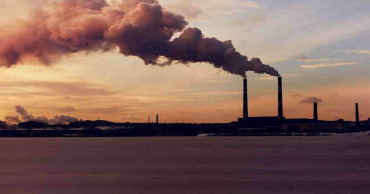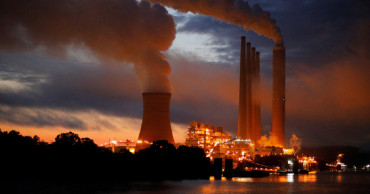Greenhouse gas
Can Green Buildings in Bangladesh Create Opportunities for Carbon Trading?
The urgency of climate change demands innovative solutions, and green building practices are emerging as a powerful force in mitigating carbon emissions. However, the potential of green buildings extends beyond simply reducing a building's carbon footprint. By implementing sustainable design and construction techniques, carbon trading opportunities can be unlocked, creating a financial incentive for environmentally responsible development.
This article focuses on the prospects of green building in Bangladesh that generates carbon credits, explores the different carbon trading mechanisms available, and ultimately showcases the exciting possibilities of leveraging sustainable building for a cleaner, more profitable future.
What Is a Green Building?
A green building is a structure that is designed, constructed, and operated in an environmentally responsible and resource-efficient manner. It focuses on sustainability by reducing the negative impact on the environment while enhancing the well-being of its occupants.
Read more: Top 3 Books in English on the Bangladesh Sundarbans
Key Features of Green Buildings
Energy Efficiency: Uses renewable energy sources (like solar or wind), energy-efficient lighting, and smart building technologies.
Water Conservation: Incorporates water-efficient fixtures, rainwater harvesting, and wastewater recycling.
Sustainable Materials: Uses eco-friendly, recycled, or locally sourced materials to minimize environmental impact.
Indoor Environmental Quality: Ensures proper ventilation, natural lighting, and non-toxic building materials for better air quality.
Waste Reduction: Promotes recycling, composting, and sustainable construction waste management.
Site Sustainability: Minimizes land disturbance, promotes green roofs, and supports biodiversity.
Low Carbon Footprint: Reduces greenhouse gas emissions through efficient design and operation.
Read more: What is Carbon Trading? How does it work?
International Certifications for Green Buildings
LEED (Leadership in Energy and Environmental Design): A widely recognized certification by the U.S. Green Building Council (USGBC).BREEAM (Building Research Establishment Environmental Assessment Method): A UK-based certification.WELL Certification: Focuses on human health and well-being.Green Star: Used in Australia.EDGE (Excellence in Design for Greater Efficiencies): Popular in developing countries.
Green buildings help combat climate change, reduce utility costs, and create healthier spaces for people to live and work.
What Is Carbon Credit?
A carbon credit is a permit or certificate that represents the right to emit one metric tonne of carbon dioxide (CO₂) or an equivalent amount of another greenhouse gas (GHG). These credits are used as part of efforts to reduce global emissions and combat climate change. Companies or entities that emit less CO₂ than their allocated limit can sell their unused credits to others that exceed their limits.
Read more: Top Strategies to Enhance Fire Resilience in Dhaka City
What Is Carbon Trading?
Carbon trading, also known as emissions trading, is the process of buying and selling carbon credits to control greenhouse gas emissions. It is part of a cap-and-trade system, where governments or regulatory bodies set a limit (cap) on total emissions and issue credits accordingly.
How Green Buildings Create Potential for Carbon Trading
Green buildings contribute to carbon trading by reducing greenhouse gas (GHG) emissions, making them eligible to generate and trade carbon credits. Here’s how:
Energy Efficiency & Lower Emissions
Green buildings use energy-efficient HVAC systems, LED lighting, and smart building technology, reducing carbon emissions from electricity consumption. By cutting fossil fuel-based energy use, buildings emit less CO₂, allowing them to earn carbon credits under emission reduction programs.
Renewable Energy Integration
Many green buildings install solar panels, wind turbines, or geothermal energy systems, reducing reliance on grid electricity generated from fossil fuels. Excess renewable energy can be fed into the grid, generating renewable energy credits (RECs) that can be sold in carbon markets.
Read more: Organizational strategies to minimize earthquake damages in Dhaka City
Sustainable Materials & Low Carbon Construction
Using low-carbon concrete, recycled steel, and timber reduces the embodied carbon in construction. Buildings that incorporate carbon capture materials (like CO₂-absorbing cement) can qualify for carbon offset programs.
Water & Waste Management
Rainwater harvesting, greywater recycling, and water-efficient fixtures reduce the energy required for water treatment and supply. Waste reduction through composting and recycling lowers methane emissions from landfills, allowing buildings to claim waste management carbon credits.
Green Certifications & Carbon Credit Eligibility
Certified green buildings (e.g., LEED, BREEAM, EDGE) may qualify for carbon offset projects, making them eligible for trading in voluntary carbon markets. Large property developers can sell carbon credits for portfolio-wide emissions reductions, making green buildings a financial asset in carbon trading.
Smart Building Technology & Carbon Monitoring
AI and IoT-based energy monitoring systems help track and reduce carbon emissions. Verified reductions can be certified as carbon credits and sold in compliance or voluntary carbon markets.
Read more: Flood Control and How to Minimise Losses
How Green Buildings in Bangladesh Can Contribute to Carbon Trading
Bangladesh has been making significant strides in sustainable architecture and green building development due to growing environmental concerns, energy efficiency needs, and compliance with international sustainability standards. The country is one of the global leaders in green industrial buildings, particularly in the textile and garment sector.
With the right implementation of carbon reduction initiatives in Bangladesh, the nation might earn billions of US dollars annually from global carbon trading. In 2022, the global carbon trading market was valued at $4.5 trillion, and it may grow to $8.98 trillion. The International Monetary Fund (IMF) suggested an average price of $75 per unit, with each carbon credit equivalent to one tonne of carbon dioxide. Carbon markets have only brought in a few hundred million US dollars for Bangladesh thus far.
Bangladesh could make much more, though, because the nation is among the lowest carbon polluters in the world, contributing only 0.5% of global emissions.
Growth of Green Buildings in Bangladesh
In Bangladesh, over 200+ factories in the ready-made garments (RMG) sector are certified by LEED (Leadership in Energy and Environmental Design) by the U.S. Green Building Council (USGBC). The trend of green commercial, residential, and industrial buildings is increasing in Dhaka, Chattogram, Gazipur, and Narayanganj.
Read more: Can a Sponge City Tackle Flooding in Dhaka?
Green Building Certifications & Policies in Bangladesh
LEED Certification (USGBC): The most recognized certification in Bangladesh.Bangladesh Green Building Guidelines: Developed by the Bangladesh Green Building Council (BGBC).EDGE Certification: Promoted by the International Finance Corporation (IFC).Sustainable & Renewable Energy Development Authority (SREDA): Encourages energy-efficient buildings.
Benefits of Green Buildings in Bangladesh
Lower Energy Costs: Reduces electricity bills through solar energy and energy-efficient appliances.Water Conservation: Rainwater harvesting and wastewater recycling.Healthier Indoor Air Quality: Improves well-being by reducing pollution.Carbon Credit Trading: Potential to earn revenue by reducing CO₂ emissions.Global Market Competitiveness: Many eco-friendly garment factories attract international buyers.
Read more: How to Build Dhaka as a Water Wise City
How Bangladesh Can Sell Carbon Credits
First, identification of green industry projects.
Then, get certified by Carbon Standards. The green industry projects must be verified and registered under recognized carbon credit standards such as the Gold Standard (GS), Verified Carbon Standard (VCS), Clean Development Mechanism (CDM) of UNFCCC, etc.
After that, emission reductions will be verified. Certified auditors measure CO₂ reduction to validate the credits.
Finally, engaging in the global carbon trading markets. There are two types of carbon trading markets:
Compliance Carbon Market: Sell credits to companies in regulated markets like the EU Emissions Trading System (ETS).
Voluntary Carbon Market (VCM): Sell credits to international companies looking to offset emissions voluntarily.
Read more: Green Roofs in Dhaka City: Pathway to Smart Urban Agriculture
Challenges for Bangladesh in Carbon Trading and Probable Solutions
A lack of awareness and expertise in carbon trading has limited the scope of Bangladesh's earnings from selling carbon credits in the international markets. High initial costs for certification are another bar. Furthermore, the country have a limited policy and regulatory framework that can support the carbon trading process. Verification and monitoring issues are also required to enhance the potential of Bangladesh in this sector.
To overcome these limitations, essential training and capacity-building programs on carbon trading can be helpful. Government incentives and subsidies can encourage commercial projects, industrial establishments, and residential owners to opt for green buildings.
Therefore, a national carbon trading policy should be developed and a national carbon credit registry should be introduced to streamline the process in Bangladesh. Public-private partnerships (PPP) can drive large-scale green building projects in different districts. Moreover, foreign investments in green building and associated carbon offset projects should be encouraged to enhance the country’s carbon trading scope. Expanding the carbon market to SMEs and rural green industries can boost economic benefits. Besides these, by partnering with international carbon credit certifiers, Bangladesh can go a long way in carbon trading.
Read more: What Can Dhaka Learn from the Smart City Singapore
Final Thoughts
Green buildings reduce carbon emissions and create financial opportunities through carbon trading, encouraging real estate developers, corporations, and governments to invest in sustainable construction.
Bangladesh has been leading the way in green industrial buildings, especially in the garment sector, and is gradually expanding to commercial and residential areas. The country have huge potential to earn from carbon trading by promoting green industries and green building projects. With the right policies, international partnerships, and investments, Bangladesh can turn carbon reduction into a financial asset while combating climate change.
Read more: Plastic Pollution: Harmful effects on human health and environment
10 months ago
Biden directs US to mitigate financial risk from climate
President Joe Biden is directing federal agencies to develop a comprehensive strategy to identify and manage financial risks to government and the private sector posed by climate change.
An executive order Biden issued Thursday calls for concrete steps to mitigate climate risks, while protecting workers’ life savings, spurring job creation and helping the United States lower greenhouse gas emissions that contribute to climate change.
New regulations could be issued on the banking, housing and agriculture sectors, among others.
“Extreme weather related to climate change can disrupt entire supply chains and deprive communities of food, water or emergency supplies,″ the White House said in a statement Thursday.
Snowstorms can knock power grids offline, while floods made worse by rising sea levels can destroy homes and businesses.
Read: Biden hails Israel-Hamas cease-fire, sees ‘opportunity’
The new strategy is intended to identify public and private financing needed to mitigate such risks and help safeguard Americans’ financial security, the White House said.
Biden has made slowing climate change a top priority and has set a target to cut U.S. greenhouse gas emissions by up to 52% below 2005 levels by 2030. He also has said he expects to adopt a clean energy standard that would make electricity carbon-free by 2035, along with the wider goal of net-zero carbon emissions economywide by 2050.
The executive order directs White House climate adviser Gina McCarthy and economic adviser Brian Deese to develop a government-wide strategy within four months to identify and disclose climate-related financial risks. Treasury Secretary Janet Yellen and the White House Office of Management and Budget also would be involved, while the Labor Department will analyze how to protect pensions from climate-related risk.
Yellen also will be directed to share climate-related financial risk data and issue a separate report within six months.
The Securities and Exchange Commission has already begun work on potential regulations that would require companies to disclose risks related to global warming, while Federal Reserve Chairman Jerome Powell said his agency has begun taking steps to assess climate change-related risks to the banking system.
Whether through rising seas or extreme weather, climate change “already presents increasing risks to infrastructure, investments and businesses. Yet, these risks are often hidden,” the White House said.
“From signing a loan for a new home or small business to managing life savings or a retirement fund, it is important for the American people to have access to the information needed to understand the potential risks associated with these significant financial decisions,” the administration explained.
The new executive order “ensures that the right rules are in place to properly analyze and mitigate these risks″ and disclose them to the public, “empowering the American people to make informed financial decisions,″ the White House said.
Read: US civil rights leader urges Biden To give 60 million Covid-19 vaccine doses to India
Environmental groups hailed the executive order, saying Biden recognizes the enormous risks posed by climate change.
“The Biden administration affirmed today it recognizes that corporate disclosure and voluntary commitments alone are not sufficient for addressing systemic climate risks and that regulators must act,″ said Ben Cushing, a financial advocacy campaign manager for the Sierra Club.
Twelve Republican senators wrote a letter to Powell earlier this year accusing the central bank of moving “beyond the scope of the Federal Reserve’s mission” by increasing scrutiny of climate threats.
4 years ago
Average temperature in central Arctic may grow by 20 degrees by 2100: Research
Experts of the Marchuk Institute of Numerical Mathematics (the Russian Academy of Sciences) forecast the greenhouse gases’ emissions into the atmosphere will raise the average air temperature in the Arctic basin by 20 degrees, the institute’s lead researcher, Evgeny Volodin told TASS.
4 years ago
UK helps reduce over 30m tonnes of greenhouse gas emissions globally
Around 31 million tonnes of greenhouse gas emissions were reduced globally in the last nine years as a result of the UK intervention, equivalent to taking 6.7 million cars off the road for a year, according to new climate finance data.
5 years ago
Deaths caused by climate change could rise by century's end: study
A new study warns that rising temperatures driven by climate change could cause millions of deaths per year by the end of the century.
5 years ago
Greenhouse gas emission hits record high: WMO
Record amount of the three main heat-trapping gases– carbon dioxide (CO2), methane, and nitrous oxide – emitted into the atmosphere in 2018, according to a report from the UN’s World Meteorological Organization.
6 years ago


.jpg)







